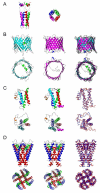Recent Advances in the Application of Solution NMR Spectroscopy to Multi-Span Integral Membrane Proteins
- PMID: 20161395
- PMCID: PMC2782866
- DOI: 10.1016/j.pnmrs.2009.07.002
Recent Advances in the Application of Solution NMR Spectroscopy to Multi-Span Integral Membrane Proteins
Figures









Similar articles
-
A theoretical assessment of structure determination of multi-span membrane proteins by oriented sample solid-state NMR spectroscopy.Aust J Chem. 2020;73(3):246-251. doi: 10.1071/CH19307. Epub 2019 Sep 20. Aust J Chem. 2020. PMID: 33162560 Free PMC article.
-
Solution NMR study of the transmembrane domain of single-span membrane proteins: opportunities and strategies.Curr Protein Pept Sci. 2012 Sep;13(6):585-600. doi: 10.2174/138920312803582979. Curr Protein Pept Sci. 2012. PMID: 23004360 Review.
-
Solution NMR spectroscopy of membrane proteins.Biochim Biophys Acta Biomembr. 2020 Sep 1;1862(9):183356. doi: 10.1016/j.bbamem.2020.183356. Epub 2020 May 13. Biochim Biophys Acta Biomembr. 2020. PMID: 32416193 Review.
-
Solution NMR study of integral membrane proteins.Curr Opin Chem Biol. 2011 Aug;15(4):560-9. doi: 10.1016/j.cbpa.2011.05.025. Curr Opin Chem Biol. 2011. PMID: 21684799 Review.
-
Sample Preparation and Technical Setup for NMR Spectroscopy with Integral Membrane Proteins.Methods Mol Biol. 2020;2127:373-396. doi: 10.1007/978-1-0716-0373-4_24. Methods Mol Biol. 2020. PMID: 32112334
Cited by
-
Bacterial Synthesis and Purification of Normal and Mutant Forms of Human FGFR3 Transmembrane Segment.Acta Naturae. 2011 Jul;3(3):77-84. Acta Naturae. 2011. PMID: 22649697 Free PMC article.
-
NMR-based conformational ensembles explain pH-gated opening and closing of OmpG channel.J Am Chem Soc. 2013 Oct 9;135(40):15101-13. doi: 10.1021/ja408206e. Epub 2013 Oct 1. J Am Chem Soc. 2013. PMID: 24020969 Free PMC article.
-
Reverse micelle encapsulation of membrane-anchored proteins for solution NMR studies.Structure. 2010 Jan 13;18(1):9-16. doi: 10.1016/j.str.2009.11.010. Structure. 2010. PMID: 20152148 Free PMC article.
-
Cell-free expressed bacteriorhodopsin in different soluble membrane mimetics: biophysical properties and NMR accessibility.Structure. 2013 Mar 5;21(3):394-401. doi: 10.1016/j.str.2013.01.005. Epub 2013 Feb 14. Structure. 2013. PMID: 23415558 Free PMC article.
-
Combinatorial triple-selective labeling as a tool to assist membrane protein backbone resonance assignment.J Biomol NMR. 2012 Mar;52(3):197-210. doi: 10.1007/s10858-012-9601-1. Epub 2012 Jan 18. J Biomol NMR. 2012. PMID: 22252484 Free PMC article.
References
-
- Goffeau A, Barrell BG, Bussey H, Davis RW, Dujon B, Feldmann H, Galibert F, Hoheisel JD, Jacq C, Johnston M, Louis EJ, Mewes HW, Murakami Y, Philippsen P, Tettelin H, Oliver SG. Science. 1996;274:546. - PubMed
-
- Jimonet P, Jager R. Curr. Opin. Drug. Discov. Devel. 2004;7:325. - PubMed
-
- Schnur DM, Hermsmeier MA, Tebben AJ. J. Med. Chem. 2006;49:2000. - PubMed
Grants and funding
LinkOut - more resources
Full Text Sources
Other Literature Sources

